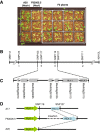Identification of a dominant gene in Medicago truncatula that restricts nodulation by Sinorhizobium meliloti strain Rm41
- PMID: 24934080
- PMCID: PMC4070093
- DOI: 10.1186/1471-2229-14-167
Identification of a dominant gene in Medicago truncatula that restricts nodulation by Sinorhizobium meliloti strain Rm41
Abstract
Background: Leguminous plants are able to form a root nodule symbiosis with nitrogen-fixing soil bacteria called rhizobia. This symbiotic association shows a high level of specificity. Beyond the specificity for the legume family, individual legume species/genotypes can only interact with certain restricted group of bacterial species or strains. Specificity in this system is regulated by complex signal exchange between the two symbiotic partners and thus multiple genetic mechanisms could be involved in the recognition process. Knowledge of the molecular mechanisms controlling symbiotic specificity could enable genetic improvement of legume nitrogen fixation, and may also reveal the possible mechanisms that restrict root nodule symbiosis in non-legumes.
Results: We screened a core collection of Medicago truncatula genotypes with several strains of Sinorhizobium meliloti and identified a naturally occurring dominant gene that restricts nodulation by S. meliloti Rm41. We named this gene as Mt-NS1 (for M.truncatulanodulation specificity 1). We have mapped the Mt-NS1 locus within a small genomic region on M. truncatula chromosome 8. The data reported here will facilitate positional cloning of the Mt-NS1 gene.
Conclusions: Evolution of symbiosis specificity involves both rhizobial and host genes. From the bacterial side, specificity determinants include Nod factors, surface polysaccharides, and secreted proteins. However, we know relatively less from the host side. We recently demonstrated that a component of this specificity in soybeans is defined by plant NBS-LRR resistance (R) genes that recognize effector proteins delivered by the type III secretion system (T3SS) of the rhizobial symbionts. However, the lack of a T3SS in many sequenced S. meliloti strains raises the question of how the specificity is regulated in the Medicago-Sinorhizobium system beyond Nod-factor perception. Thus, cloning and characterization of Mt-NS1 will add a new dimension to our knowledge about the genetic control of nodulation specificity in the legume-rhizobial symbiosis.
Figures



Similar articles
-
Paired Medicago receptors mediate broad-spectrum resistance to nodulation by Sinorhizobium meliloti carrying a species-specific gene.Proc Natl Acad Sci U S A. 2022 Dec 20;119(51):e2214703119. doi: 10.1073/pnas.2214703119. Epub 2022 Dec 12. Proc Natl Acad Sci U S A. 2022. PMID: 36508666 Free PMC article.
-
Sinorhizobium medicae WSM419 Genes That Improve Symbiosis between Sinorhizobium meliloti Rm1021 and Medicago truncatula Jemalong A17 and in Other Symbiosis Systems.Appl Environ Microbiol. 2021 Jul 13;87(15):e0300420. doi: 10.1128/AEM.03004-20. Epub 2021 Jul 13. Appl Environ Microbiol. 2021. PMID: 33990306 Free PMC article.
-
The non-specific lipid transfer protein N5 of Medicago truncatula is implicated in epidermal stages of rhizobium-host interaction.BMC Plant Biol. 2012 Dec 7;12:233. doi: 10.1186/1471-2229-12-233. BMC Plant Biol. 2012. PMID: 23217154 Free PMC article.
-
How rhizobial symbionts invade plants: the Sinorhizobium-Medicago model.Nat Rev Microbiol. 2007 Aug;5(8):619-33. doi: 10.1038/nrmicro1705. Nat Rev Microbiol. 2007. PMID: 17632573 Free PMC article. Review.
-
Exploring the role of symbiotic modifier peptidases in the legume - rhizobium symbiosis.Arch Microbiol. 2024 Mar 11;206(4):147. doi: 10.1007/s00203-024-03920-w. Arch Microbiol. 2024. PMID: 38462552 Review.
Cited by
-
The chromosome-level genome assembly of Astragalus sinicus and comparative genomic analyses provide new resources and insights for understanding legume-rhizobial interactions.Plant Commun. 2021 Nov 8;3(2):100263. doi: 10.1016/j.xplc.2021.100263. eCollection 2022 Mar 14. Plant Commun. 2021. PMID: 35529952 Free PMC article.
-
Genetic and Molecular Mechanisms Underlying Symbiotic Specificity in Legume-Rhizobium Interactions.Front Plant Sci. 2018 Mar 9;9:313. doi: 10.3389/fpls.2018.00313. eCollection 2018. Front Plant Sci. 2018. PMID: 29593768 Free PMC article. Review.
-
The complete genome sequence of Ensifer meliloti strain CCMM B554 (FSM-MA), a highly effective nitrogen-fixing microsymbiont of Medicago truncatula Gaertn.Stand Genomic Sci. 2017 Dec 13;12:75. doi: 10.1186/s40793-017-0298-3. eCollection 2017. Stand Genomic Sci. 2017. PMID: 29255570 Free PMC article.
-
Paired Medicago receptors mediate broad-spectrum resistance to nodulation by Sinorhizobium meliloti carrying a species-specific gene.Proc Natl Acad Sci U S A. 2022 Dec 20;119(51):e2214703119. doi: 10.1073/pnas.2214703119. Epub 2022 Dec 12. Proc Natl Acad Sci U S A. 2022. PMID: 36508666 Free PMC article.
-
Naturally occurring variations in the nod-independent model legume Aeschynomene evenia and relatives: a resource for nodulation genetics.BMC Plant Biol. 2018 Apr 3;18(1):54. doi: 10.1186/s12870-018-1260-2. BMC Plant Biol. 2018. PMID: 29614957 Free PMC article.
References
-
- Fowler D, Coyle M, Skiba U, Sutton MA, Cape JN, Reis S, Sheppard LJ, Jenkins A, Grizzetti B, Galloway JN, Vitousek P, Leach A, Bouwman AF, Butterbach-Bahl K, Dentener F, Stevenson D, Amann M, Voss M. The global nitrogen cycle in the twenty-first century. Philos Trans R Soc Lond B Biol Sci. 2013;368:20130164. doi: 10.1098/rstb.2013.0164. - DOI - PMC - PubMed
Publication types
MeSH terms
Substances
LinkOut - more resources
Full Text Sources
Other Literature Sources
Research Materials
Miscellaneous

